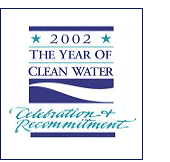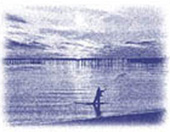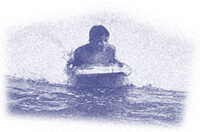Water: Educator Resources
What's Up With Our Nation's Waters?
Download printable version of document
 "River Otter in the Wilderness," Molly J., Age 10, California, Art Finalist |
 "Quick as My Thought," Rachel R., Age 8, California, Art Winner Category II (Grades 3-6) |
 "Submerge in the Wonder," Courtney M., Age 17, Georgia, Art Finalist |
 |
||
| "Heal the World," Eon H., Age 15, Georgia, Art Winner Category IV (Grades 10-12) | ||
| Artwork from The River of Words 2000 art contest | ||
 |
||
 |
We all need clean water. After all, our bodies are at least 65 percent water. Fish and wildlife depend on clean water to survive. We need clean water to grow crops and to operate factories, and we need clean water for drinking, swimming, surfing, fishing and sailing. |  |
Test your water smarts!
- True or false: Watersheds are located mainly in mountainous regions with high rainfall.
- Circle the correct answer: Most of the pollutants entering our waters come from the following sources:
A. Wastewater treatment plants
B. Runoff from fields and streets
C. Factories along rivers - True or false: Students can join organizations to help monitor their waters.
| What is the U.S.Environmental Protection Agency?
How often does EPA report on the nation's waters? EPA and the states* are directed by the Clean Water Act (CWA) to help protect the health of our nation's waters. The CWA gives states the authority and responsibility to establish water quality standards, which set minimum requirements for fish habitat, swimming, and drinking water sources. States, under Section 305(b) of CWA, are required to assess the health of their waters and submit the information to EPA every two years. EPA gathers the information from every state and prepares a report called the National Water Quality Inventory. To see the latest 305(b) report or other information on the quality of our nation's waters, visit http://www.epa.gov/305b/ on the Internet. |
|||
|
* When EPA says "state," it means states, territories, Indian tribes, and other jurisdictions. |
This document, which was previously published as EPA 841-F-00-005, is also available by contacting the National Service Center for Environmental Publications, 1-800-490-9198.

 The U.S. Environmental Protection Agency, or EPA, is responsible for protecting human health and the natural environment from pollution. EPA does this by conducting research, enforcing laws, developing national policies, and providing information and technical help to states and communities.
The U.S. Environmental Protection Agency, or EPA, is responsible for protecting human health and the natural environment from pollution. EPA does this by conducting research, enforcing laws, developing national policies, and providing information and technical help to states and communities.